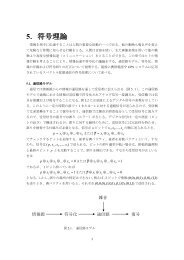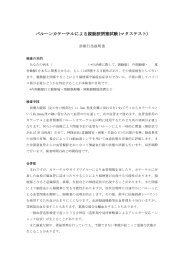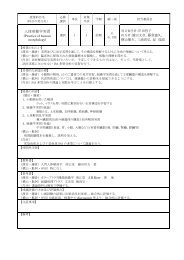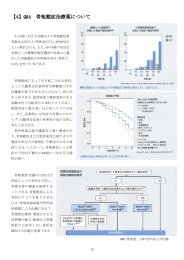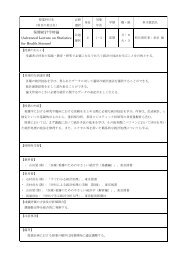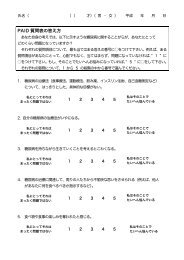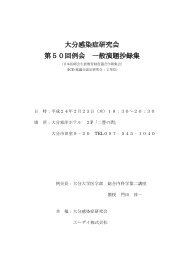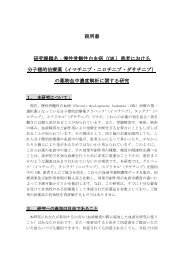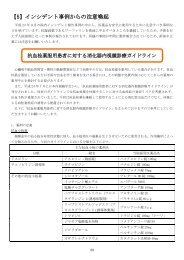REVIEWSMARFAN SYNDROMEA heritable connective tissuedisease that affects several organsystems, including the skeleton,eyes, lungs, heart and bloodvessels. The disease is caused bydominant mutations in thefibrillin-1 gene.(which results in an S227P substitution; where S is serineand P is proline) in FBLN5 in a <strong>family</strong> that wasaffected by a severe form <strong>of</strong> cutis laxa 79 . S227 is locatedbetween Cys3 and Cys4 in cbEGF3 <strong>of</strong> fibulin-5. Thisamino-acid substitution is probably the cause <strong>of</strong> cutislaxa in this <strong>family</strong>, as the corresponding position inmost <strong>of</strong> the cbEGF-like modules in fibrillin-1 is occupiedby a serine, and an analogous mutation in fibrillin-1results in MARFAN SYNDROME. Although the heterozygouscarriers <strong>of</strong> the missense mutation in this<strong>family</strong> are not affected, cutis laxa can result from a heterozygousmutation in fibulin-5. A patient with amilder phenotype <strong>of</strong> cutis laxa carries a heterozygoustandem gene duplication <strong>of</strong> 22 kb in FBLN5, whichresults in the duplication <strong>of</strong> exons 5–8 that encodefour cbEGF-like domains 80 . The mutant fibulin-5 proteinwith four extra cbEGF-like domains is synthesizedand secreted by the patient’s fibroblasts inamounts that are somewhat greater than for a normalcounterpart, so the mutation probably exerts adominant-negative effect.Conclusions and perspectivesThe <strong>fibulins</strong> represent a newly characterized <strong>family</strong> <strong>of</strong>calcium-binding ECM <strong>proteins</strong> and five is<strong>of</strong>orms haveso far been characterized from mammalian species. The<strong>fibulins</strong> do not form large homotypic aggregates, in contrastto many other ECM <strong>proteins</strong>, but they have theability to join other supramolecular structures as diverseas basement-membrane networks, elastic fibres, severaltypes <strong>of</strong> micr<strong>of</strong>ibrils and proteoglycan aggregates. Theirinclusion, in part, stabilizes these structures, but alsoextends their repertoire <strong>of</strong> biological functions. The latterpoint is highlighted by genetic studies <strong>of</strong> inheriteddiseases and <strong>of</strong> transgenic animals. Some <strong>fibulins</strong> alsohave the ability to interact with cells, in part, throughinteractions with RGD-dependent integrins. There isalso increasing evidence that <strong>fibulins</strong> control the growth<strong>of</strong> normal and malignant cells. These studies are still in apreliminary stage and, in the future, a comprehensivecharacterization <strong>of</strong> the receptors and signal-transductionpathways involved will be required in order to evaluatetheir biological significance.1. Argraves, W. S., Dickerson, K., Burgess, W. H. & Ruoslahti, E.Fibulin, a novel protein that interacts with the fibronectinreceptor β subunit cytoplasmic domain. Cell 58, 623–629(1989).2. Argraves, W. S., Tran, H., Burgess, W. H. & Dickerson, K.Fibulin is an <strong>extracellular</strong> <strong>matrix</strong> and plasma glycoproteinwith repeated domain structure. J. Cell Biol. 111,3155–3164 (1990).Fibulin-1 is identified and is found to be a new class <strong>of</strong>ECM protein.3. Kluge, M., Mann, K., Dziadek, M. & Timpl, R.Characterization <strong>of</strong> a novel calcium-binding 90-kDaglycoprotein (BM-90) shared by basement membranes andserum. Eur. J. Biochem. 193, 651–659 (1990).4. Pan, T.-C. et al. Sequence <strong>of</strong> <strong>extracellular</strong> mouse proteinBM-90/fibulin and its calcium-dependent binding to otherbasement membrane ligands. Eur. J. Biochem. 215,733–740 (1993).5. Pan, T.-C. et al. Structure and expression <strong>of</strong> fibulin-2, a novel<strong>extracellular</strong> <strong>matrix</strong> protein with multiple EGF-like repeatsand consensus motifs for calcium-binding. J. Cell Biol. 123,1269–1277 (1993).The first evidence that there is a fibulin protein <strong>family</strong>that contains different fibulin is<strong>of</strong>orms.6. Zhang, R.-Z. et al. Fibulin-2 (FBLN2): human cDNAsequence, mRNA expression and mapping <strong>of</strong> the gene onhuman and mouse chromosomes. Genomics 22, 425–430(1994).7. Sasaki, T., Göhring, W., Pan, T.-C., Chu, M.-L. & Timpl, R.Binding <strong>of</strong> mouse and human fibulin-2 to <strong>extracellular</strong> <strong>matrix</strong>ligands. J. Mol. Biol. 254, 892–899 (1995).8. Sasaki, T. et al. Dimer model for the micr<strong>of</strong>ibrillar proteinfibulin-2 and identification <strong>of</strong> the connecting disulfide bridge.EMBO J. 16, 3035–3043 (1997).The first extensive model <strong>of</strong> the fibulin-2 structure.9. Tran, H., Mattei, M., Godyna, S. & Argraves, W. S. HumanFibulin-1D: molecular cloning, expression and similarity withS1-5 protein, a new member <strong>of</strong> the fibulin-1 gene <strong>family</strong>.Matrix Biol. 15, 479–493 (1997).10. Giltay, R., Timpl, R. & Kostka, G. Sequence, recombinantexpression and tissue localization <strong>of</strong> two novel <strong>extracellular</strong><strong>matrix</strong> <strong>proteins</strong>, fibulin-3 and fibulin-4. Matrix Biol. 18,469–480 (1999).11. Zhang, H.-Y., Lardelli, M. & Ekblom, P. Sequence <strong>of</strong> zebrafishfibulin-1 and its expression in developing heart and otherembryonic organs. Dev. Genes Evol. 207, 340–351 (1997).12. Barth, J. L., Argraves, K. M., Roark, E. F., Little, C. D. &Argraves, W. S. Identification <strong>of</strong> chicken andC. elegans fibulin-1 homologs and characterization<strong>of</strong> the C. elegans fibulin-1 gene. Matrix Biol. 17, 635–646(1998).13. Huber, R., Scholze, H., Paques, E. P. & Deisenh<strong>of</strong>er, J.Crystal structure analysis and molecular model <strong>of</strong> humanC3a anaphylatoxin. Hoppe-Seyler’s Z. Physiol. Chem. 361,1389–1399 (1989).14. Lecka-Czernik, B., Lumpkin, C. K. & Goldstein, S.An overexpressed gene transcript in senescent andquiescent human fibroblasts encoding a novel protein in theepidermal growth factor-like repeat <strong>family</strong> stimulates DNAsynthesis. Mol. Cell. Biol. 15, 120–129 (1995).15. Gallagher, W. M. et al. Human fibulin-4: analysis<strong>of</strong> its biosynthetic processing and mRNA expression innormal and tumour tissues. FEBS Lett. 489, 59–66(2001).16. Maurer, P. & Hohenester, E. Structural and functionalaspects <strong>of</strong> calcium-binding in <strong>extracellular</strong> <strong>matrix</strong> <strong>proteins</strong>.Matrix Biol. 15, 569–580 (1997).17. Downing, A. K. et al. Solution structure <strong>of</strong> a pair <strong>of</strong> calciumbindingepidermal growth factor-like domains: implicationsfor the Marfan syndrome and other genetic disorders. Cell85, 597–605 (1996).This paper explains how the structure <strong>of</strong> cbEGF-likemodules is stabilized by calcium ligation.18. Sasaki, T., Mann, K., Murphy, G., Chu, M.-L. & Timpl, R.Different susceptibilities <strong>of</strong> fibulin-1 and fibulin-2 to cleavageby <strong>matrix</strong> metalloproteinases and other tissue proteases.Eur. J. Biochem. 240, 427–434 (1996).19. Sasaki, T. et al. Structural characterization <strong>of</strong> two variants <strong>of</strong>fibulin-1 that differ in nidogen affinity. J. Mol. Biol. 245,241–250 (1995).20. Roark, E. F. et al. The association <strong>of</strong> human fibulin-1with elastic fibers: an immunohistological, ultrastructural,and RNA study. J. Histochem. Cytochem. 43, 401–411(1995).21. Stone, E. M. et al. A single EFEMP1 mutationassociated with both Malattia Leventinese and Doynehoneycomb retinal dystrophy. Nature Genet. 22, 199–202(1999).22. Nakamura, T. et al. Fibulin-5/DANCE is essential forelastogenesis in vivo. Nature 415, 171–175 (2002).23. Yanagisawa, H. et al. Fibulin-5 is an elastin-binding proteinessential for elastic fibre development in vivo. Nature 415,168–171 (2002).This work describes, together with reference 22, therole <strong>of</strong> fibulin-5 in stabilizing elastic fibres.24. Spence, S. G., Argraves, W. S., Walters, L., Hungerford, J. E.& Little, C. Fibulin is localized at sites <strong>of</strong>epithelial–mesenchymal transitions in the early avianembryo. Dev. Biol. 151, 473–484 (1992).25. Zhang, H.-Y., Timpl, R., Sasaki, T., Chu, M.-L. & Ekblom, P.Fibulin-1 and fibulin-2 expression during organogenesis inthe developing mouse embryo. Dev. Dyn. 205, 348–364(1996).26. Miosge, N. et al. The <strong>extracellular</strong> <strong>matrix</strong> <strong>proteins</strong> fibulin-1and fibulin-2 in the early human embryo. Histochem. J. 28,109–116 (1996).27. Hungerford, J. E., Owens, G. K., Argraves, W. S. & Little, C. D.Development <strong>of</strong> aortic vessel wall as defined by vascularsmooth muscle and <strong>extracellular</strong> <strong>matrix</strong> markers. Dev. Biol.178, 375–392 (1996).28. Bouchey, D., Argraves, W. S. & Little, C. D. Fibulin-1,vitronectin expression during avian cardiac valveand septa development. Anat. Rec. 244, 540–551(1996).29. Zhang, H.-Y., Kluge, M., Timpl, R., Chu, M.-L. & Ekblom, P.The <strong>extracellular</strong> <strong>matrix</strong> glyco<strong>proteins</strong> BM-90 and tenascinare expressed in the mesenchyme at sites <strong>of</strong>endothelial–mesenchymal conversion in the embryonicmouse heart. Differentiation 52, 211–220 (1993).30. Zhang, H.-Y. et al. Extracellular <strong>matrix</strong> protein fibulin-2 isexpressed in the embryonic endocardial cushion tissue andis a prominent component <strong>of</strong> valves in adult heart. Dev. Biol.167,18–26 (1995).31. Tsuda, T., Wang, H., Timpl, R. & Chu, M.-L. Fibulin-2expression marks transformed mesenchymal cells indeveloping cardiac valves, aortic arch vessels and coronaryvessels. Dev. Dyn. 222, 89–100 (2001).32. Miosge, N., Sasaki, T., Chu, M.-L., Herken, R. & Timpl, R.Ultrastructural localization <strong>of</strong> micr<strong>of</strong>ibrillar fibulin-1 andfibulin-2 during heart development indicates a switch inmolecular associations. Cell. Mol. Life Sci. 54, 606–613(1997).33. Gallagher, W. M. et al. MBP1: a novel mutant p53-specificprotein partner with oncogenic properties. Oncogene 18,3608–3616 (1999).34. Kowal, R. C., Richardson, J. A., Miano, J. M. & Olsen, E. N.EVEC. A novel epidermal growth factor-like repeatcontaining protein upregulated in embryonic and injuredadult vasulature. Circ. Res. 84, 1166–1176 (1999).35. Ohsawa, I., Takamura, C. & Kohsaka, S. Fibulin-1 binds theamino-terminal head <strong>of</strong> β-amyloid precursor protein.J. Neurochem. 76, 1411–1420 (2001).36. Reinhardt, D. P. et al. Fibrillin-1 and fibulin-2 interact and arecolocalized in some tissues. J. Biol. Chem. 271,19489–19496 (1996).37. Sasaki, T. et al. Tropoelastin binding to <strong>fibulins</strong>, nidogen-2and other <strong>extracellular</strong> <strong>matrix</strong> <strong>proteins</strong>. FEBS Lett. 460,280–284 (1999).38. Sasaki, T., Wiedemann, H., Matzner, M., Chu, M.-L. & Timpl, R.Expression <strong>of</strong> fibulin-2 by fibroblasts and deposition withfibronectin into a fibrillar <strong>matrix</strong>. J. Cell Sci. 109, 2895–2904(1996).39. Loveland, K. et al. Developmental changes in the basementmembrane <strong>of</strong> the normal and hypothyroid postnatal rattestis: segmental localization <strong>of</strong> fibulin-2 and fibronectin.Biol. Reprod. 58, 1123–1130 (1998).40. Raghunath, M. et al. Confocal laser scanning analysis <strong>of</strong> theassociation <strong>of</strong> fibulin-2 with fibrillin-1 and fibronectin definedifferent stages <strong>of</strong> skin regeneration. J. Invest. Dermatol.112, 97–101 (1999).41. Fässler, R., Sasaki, T., Timpl, R., Chu, M.-L. & Werner, S.Differential regulation <strong>of</strong> fibulin, tenascin and nidogenexpression during wound healing <strong>of</strong> normal andglucocorticoid-treated mice. Exp. Cell Res. 222, 111–116(1996).488 | JUNE 2003 | VOLUME 4 www.nature.com/reviews/molcellbio© 2003 Nature PublishingGroup
REVIEWS42. Hunzelmann, N., Nischt, R., Brenneisen, P., Eickert, A. &Krieg, T. Increased deposition <strong>of</strong> fibulin-2 in solar elastosisand its colocalization with elastic fibers. Brit. J. Dermatol.145, 217–222 (2001).43. Kusubata, M. et al. Spatiotemporal changes <strong>of</strong> fibronectin,tenascin-C, fibulin-1, and fibulin-2 in the skin during thedevelopment <strong>of</strong> chronic contact dermatitis. J. Invest.Dermatol. 113, 906–912 (1999).44. Roger, P., Pujol, P., Lucas, A., Baldet, P. & Rochefort, H.Increased immunostaining <strong>of</strong> fibulin-1, an estrogenregulatedprotein in the stroma <strong>of</strong> human ovarian epithelialtumors. Am. J. Pathol. 153, 1579–1588 (1998).45. Balbona, K. et al. Fibulin binds to itself and to the carboxylterminalheparin-binding region <strong>of</strong> fibronectin. J. Biol. Chem.267, 20120–20125 (1992).46. Tran, H., Van Dusen, W. J. & Argraves, W. S. The selfassociationand fibronectin-binding sites <strong>of</strong> fibulin-1 map tocalcium-binding epidermal growth factor-like domains.J. Biol. Chem. 272, 22600–22606 (1997).47. Roman, J. & McDonald, J. A. Fibulin’s organization into the<strong>extracellular</strong> <strong>matrix</strong> <strong>of</strong> fetal lung fibroblasts is dependent onfibronectin <strong>matrix</strong> assembly. Am. J. Respir. Cell Mol. Biol. 8,538–545 (1993).48. Godyna, S., Mann, D. M. & Argraves, W. S. A quantitativeanalysis <strong>of</strong> the incorporation <strong>of</strong> fibulin-1 into the <strong>extracellular</strong><strong>matrix</strong> indicates that fibronectin assembly is required.Matrix Biol. 14, 467–477 (1994).49. Adam, S. et al. Binding <strong>of</strong> fibulin-1 to nidogen depends onits C-terminal globular domain and a specific array <strong>of</strong>calcium-binding epidermal growth factor-like (EG) modules.J. Mol. Biol. 272, 226–236 (1997).50. Ries, A., Göhring, W., Fox, J. W., Timpl, R. & Sasaki, T.Recombinant domains <strong>of</strong> mouse nidogen-1 and theirbinding to basement membrane <strong>proteins</strong> and monoclonalantibodies. Eur. J. Biochem. 268, 5119–5128 (2001).51. Friedrich, M. V. K. et al. Structural basis <strong>of</strong>glycosaminoglycan modification and <strong>of</strong> heterotypicinteractions <strong>of</strong> perlecan domain V. J. Mol. Biol. 294,259–270 (1999).52. Hopf, M., Göhring, W., Mann, K. & Timpl, R. Mapping <strong>of</strong>binding sites for nidogens, fibulin-2, fibronectin and heparinto different IG modules <strong>of</strong> perlecan. J. Mol. Biol. 311,529–541 (2001).53. Timpl, R. et al. Structure and function <strong>of</strong> laminin LGmodules. Matrix Biol. 19, 309–317 (2000).54. Talts, J. F., Andac, Z., Göhring, W., Brancaccio, A. & Timpl, R.Binding <strong>of</strong> the G domains <strong>of</strong> laminin α1 and α2 chainsand perlecan to heparin, sulfatides, α-dystroglycan andseveral <strong>extracellular</strong> <strong>matrix</strong> <strong>proteins</strong>. EMBO J. 18, 863–870(1999).55. Utani, A., Nomizu, M. & Yamada, Y. Fibulin-2 binds to theshort arms <strong>of</strong> laminin-5 and laminin-1 via conservedamino acid sequences. J. Biol. Chem. 272, 2814–2820(1997).56. Sasaki, T. et al. Short arm region <strong>of</strong> laminin-5 γ-2 chain:structure, mechanism <strong>of</strong> processing and binding to heparinand <strong>proteins</strong>. J. Mol. Biol. 314, 751–763 (2001).57. Sasaki, T. et al. Structure, function and tissue forms <strong>of</strong> theC-terminal globular domain <strong>of</strong> collagen XVIII containing theangiogenesis inhibitor endostatin. EMBO J. 17, 4249–4256(1998).58. Sasaki, T. et al. Endostatins derived from collagens XV andXVIII differ in structural and binding properties, tissuedistribution and anti-angiogenic activity. J. Mol. Biol. 301,1179–1190 (2000).59. Sasaki, T., Hohenester, E. & Timpl, R. Structure and function<strong>of</strong> collagen-derived endostatin inhibitors <strong>of</strong> angiogenesis.IUBMB Life 53, 77–84 (2002).60. Ruoslahti, E. Brain <strong>extracellular</strong> <strong>matrix</strong>. Glycobiology 6,489–492 (1996).61. Aspberg, A., Adam, S., Kostka, G., Timpl, R. & Heinegard, D.Fibulin-1 is a ligand for the C-type lectin domains <strong>of</strong>aggrecan and versican. J. Biol. Chem. 274, 20444–20449(1999).62. Olin, A. J. et al. The proteoglycans aggrecan and versicanform networks with fibulin-2 through their lectin domainbinding. J. Biol. Chem. 276, 1253–1261 (2001).63. Tran, H. et al. The interaction <strong>of</strong> fibulin-1 with fibrinogen.A potential role in hemostasis and thrombosis. J. Biol.Chem. 270, 19458–19464 (1995).64. Godyna, S., Dias-Ricart, M. & Argraves, W. S. Fibulin-1mediates platelet adhesion via a bridge <strong>of</strong> fibrinogen. Blood88, 2569–2577 (1996).65. Kostka, G. et al. Perinatal lethality and endothedlial cellabnormalities in several vessel compartments <strong>of</strong> fibulin-1deficient mice. Mol. Cell. Biol. 21, 7025–7034 (2001).This paper shows that a fibulin-1 deficiency causes ahaemorrhagic phenotype.66. Perbal, B. et al. The C-terminal domain <strong>of</strong> the regulatoryprotein NOVH is sufficient to promote interaction withfibulin-1C: a clue for a role <strong>of</strong> NOVH in cell-adhesionsignalling. Proc. Natl Acad. Sci. USA 96, 869–874 (1999).67. Pfaff, M., Sasaki, T., Tangemann, K., Chu, M.-L. & Timpl, R.Integrin-binding and cell-adhesion studies <strong>of</strong> <strong>fibulins</strong> reveal aparticular affinity for αIIbβ3. Exp. Cell Res. 219, 87–92 (1995).68. Twal, W. O. et al. Fibulin-1 suppression <strong>of</strong> fibronectinregulatedcell adhesion and motility. J. Cell Sci. 114,4587–4598 (2001).69. Nakamura, T. et al. DANCE, a novel secreted RGD proteinexpressed in developing, atherosclerotic, and ballooninjuredarteries. J. Biol. Chem. 274, 22476–22483 (1999).70. Schiemann, W. P., Blobe, G. C., Kalume, D. E., Pandey, A. &Lodish, H. F. Context-specific effects <strong>of</strong> fibulin-5(DANCE/EVEC) on cell proliferation, motility, and invasion.Fibulin-5 is induced by transforming growth factor-β andaffects protein kinase cascades. J. Biol. Chem. 277,27367–27377 (2002).71. Heine, H., Delude, R. L., Monks, B. G., Esperik, T. &Golenbock, D. T. Bacterial lipopolysaccharide inducesexpression <strong>of</strong> the stress response genes hop and H411.J. Biol. Chem. 274, 21049–21055 (1999).72. Qing, J. et al. Surpression <strong>of</strong> anchorage-independentgrowth and matrigel invasion and delayed tumor formationby elevated expression <strong>of</strong> fibulin-1D in humanfibrosarcoma-derived cell lines. Oncogene 15, 2159–2168(1997).73. Clinton, G. M. et al. Estrogens increase the expression <strong>of</strong>fibulin-1, an <strong>extracellular</strong> <strong>matrix</strong> protein secreted by humanovarian cancer cells. Proc. Natl Acad Sci. USA 93, 316–320(1996).74. Hayashido, Y. et al. Estradiol and fibulin-1 inhibit motility <strong>of</strong>human ovarian- and breast-cancer cells induced byfibronectin. Int. J. Cancer 75, 654–658 (1998).75. Debeer, P. et al. The fibulin-1 gene (FLBN1) is disrupted in at(12;22) associated with a complex type <strong>of</strong> synpolydactyly.J. Med. Genet. 39, 98–104 (2002).76. Tartellin, E. E. et al. Molecular genetic heterogeneity inautosomal dominant drusen. J. Med. Genet. 38, 381–384(2001).77. Marmorstein, L. Y. et al. Aberrant accumulation <strong>of</strong> EFEMP1underlies drusen formation in Malattia Leventinese and agerelatedmacular degeneration. Proc. Natl Acad. Sci. USA 99,13067–13072 (2002).78. Midwood, K. S. & Schwarzbauer, J. E. Elastic fibres: buildingbridges between cells and their <strong>matrix</strong>. Curr. Biol. 12,R279–R281 (2002).79. Loeys, B. et al. Homozygosity for a missense mutation infibulin-5 (FBLN5) results in a severe form <strong>of</strong> cutis laxa.Hum. Mol. Genet. 11, 2113–2118 (2002).80. Markova, D. et al. Genetic heterogeneity <strong>of</strong> cutis laxa:a heterozygous tandem duplication within the fibulin-5(FBLN5) gene. Am. J. Hum. Genet. 72, 998–1004 (2003).81. Kielty, C. M., Sherrat, M. J. & Shuttleworth, C. A. Elasticfibers. J. Cell Sci. 115, 2817–2828 (2002).82. Dietz, H. C. & Mecham, R. P. Mouse models <strong>of</strong> geneticdiseases resulting from mutations in elastic fiber <strong>proteins</strong>.Matrix Biol. 19, 481–488 (2000).83. Milewicz, D. M., Urban, Z. & Boyd, C. Genetic disorders<strong>of</strong> the elastic fiber system. Matrix Biol. 19, 471–480(2000).84. Pan, T.-C., Kostka, G., Zhang, R.-Z., Timpl, R. & Chu, M.-L.Complete exon–intron organization <strong>of</strong> the mouse fibulin-1gene and its comparison with the human fibulin-1 gene.FEBS Lett. 444, 38–42 (1999).85. Mattei, M. G., Pan, T.-C., Zhang, R.-Z., Timpl, R. & Chu, M.-L.The fibulin-1 gene (FBLN1) is located on humanchromosome 22 and mouse chromosome 15.Genomics 22, 437–438 (1994).86. Grässel, S., Sicot, F.-X., Gotta, S. & Chu, M.-L.Mouse fibulin-2 gene. Complete exon–intron organizationand promoter characterization. Eur. J. Biochem. 263,471–477 (1999).87. Ikegawa, S., Toda, T., Okui, K. & Nakamura, Y. Structureand chromosomal assignment <strong>of</strong> the human S1-5 gene(FBNL) that is highly homologous to fibrillin. Genomics 35,590–592 (1996).88. Katsanis, N., Venable, S., Smith, J. R. & Lupski, J. R.Isolation <strong>of</strong> a paralog <strong>of</strong> the Doyne honeycomberetinal dystrophy gene from the multiple retinopathycritical region on 11q13. Hum. Genet. 106, 66–72(2000).89. Kowal, R. C., Jolsin, J. M., Olson, E. N. & Schultz, R. A.Assignment <strong>of</strong> fibulin–5 (FBLN5) to human chromosome14q31 by in situ hybridization and radiation hybrid mapping.Cytogenet. Cell Genet. 87, 2–3 (1999).AcknowledgementsPart <strong>of</strong> the work described here was supported by research grantsfrom the Deutsche Forschungsgemeinschaft for T.S. and R.T., theEuropean Community for R.T., and the National Institutes <strong>of</strong> Healthfor M.-L.C. The authors are grateful to S. Argraves for communicatingunpublished work and to J. Uitto for critically reading themanuscript.Online linksDATABASESThe following terms in this article are linked online to:InterPro: http://www.ebi.ac.uk/interpro/AT module | cbEGF-like module | C-type lectin domain |EGF-like module | LGLocusLink: http://www.ncbi.nlm.nih.gov/LocusLink/collagen IV | fibrinogen | laminin-1Swiss-Prot: http://www.expasy.ch/ADAMTS-1 | aggrecan | brevican | fibrillin-1 | fibronectin | fibulin-1 |fibulin-2 | fibulin-3 | fibulin-4 | fibulin-5 | neurocan | nidogen-1 |perlecan | tropoelastin | versicanFURTHER INFORMATIONGenBank database: http://www.ncbi.nlm.nih.gov/Genbank/National Center for Biotechnology Information:http://www.ncbi.nlm.nih.gov/Access to this interactive links box is free online.NATURE REVIEWS | MOLECULAR CELL BIOLOGY VOLUME 4 | JUNE 2003 | 489© 2003 Nature PublishingGroup



